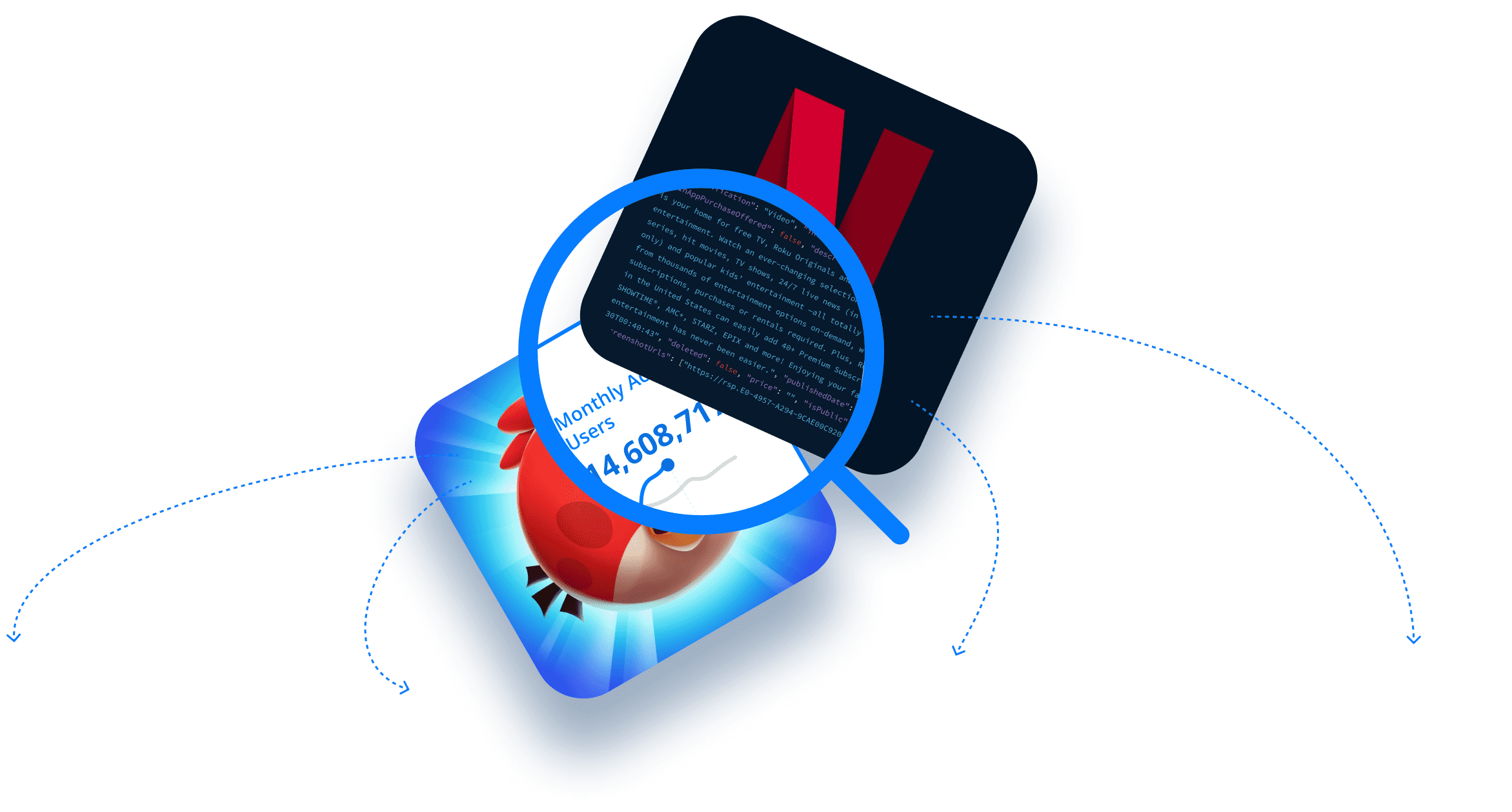App intelligence can be used to address some of the toughest challenges faced by Demand-Side Platforms (DSP) operating in the mobile and connected TV (CTV) industries, including instantaneous bid enrichment, comprehensive traffic verification, and optimized partner experiences. In this article, we look at seven of the most common pain points and how our DSP customers use our file dumps, APIs, and other mobile and CTV app intelligence solutions to address them.
Here’s what we cover (click the links below to jump to the corresponding sections):
- Pain Point #1 → App mapping for simplified omnichannel campaign experiences.
- Pain Point #2 → Improve real-time bidding (RTB) with instantaneous bid enrichment.
- Pain Point #3 → Streamline app onboarding with multi-store app metadata access.
- Pain Point #4 → Enrich app databases and inventories.
- Pain Point #5 → Improve traffic verification.
- Pain Point #6 → Maintain strong relationships with advertisers.
- Pain Point #7 → Access to bulk data from multiple stores.
Already know what data you’re after? Sign up for a free trial!
Pain Point #1 → App mapping for simplified omnichannel campaign experiences.
One of the most common challenges that you face as a DSP is providing advertisers with seamless omnichannel bidding experiences. The complexities tend to arise from the fact that each platform—whether it's the App Store, Google Play, or a connected TV (CTV) store like Roku—has their own unique app identifiers and ecosystems. This makes building campaigns that target multiple channels a painstaking process since you and your advertisers need to find the right apps to target for each channel and verify their legitimacy individually.
Fortunately, there’s an easy solution. With app intelligence tools like 42matters’ App Details file dumps, you can use package names and appIDs to map apps at scale. This means you can validate apps across stores and merge them into unified, human-readable entities. This improves app discoverability during the campaign creation process, streamlines traffic verification, and enhances post-campaign reporting capabilities.
This last point is especially important. Since bid requests typically use raw appIDs rather than human readable app names, it can be laborious for advertisers to interpret their success. By matching app bundles across stores and translating perplexing text strings into recognizable app names, you can vastly improve reporting on your platform so your advertisers can focus on designing their next campaigns.
To learn more, see how GroundTruth uses appIDs to streamline mobile and CTV media buying.
Pain Point #2 → Improve real-time bidding (RTB) with instantaneous bid enrichment.
As a DSP, RTB is your bread and butter. Improving RTB entails ensuring optimal targeting, landing highly-relevant ad placements, optimizing Return on Ad Spend (ROAS), and building trust with advertisers and publishers alike. To level-up on each of these fronts, you need access to any and all relevant app information, including app-ads.txt files, taxonomical insights, app performance metrics (downloads, MAUs, etc.), audience insights, and more.
However, the RTB process happens in milliseconds, so efficiency is also key. In order to verify traffic, audit millions of bid requests, and place competitive bids at scale, you need the data mentioned above in a format that facilitates instantaneous data transfers. Lighter-weight solutions like APIs are too narrowly focused to accommodate such broad data requirements and managing a fleet of APIs would slow down the process too much to be of any use.
So, if you want to adequately validate sources, make informed targeting decisions, and implement advertiser-centric bidding strategies, the only solution is to maintain massive databases that can be efficiently queried at runtime. To do this, you can either build them in house (along with the crawlers necessary to collect the data from app stores and maintain the data quality over time) or invest in a third-party solution. We recommend the latter since it’s cheaper and easier.
Indeed, many of our DSP customers use our app details file dumps to power RTB at runtime. Here are some of the most popular uses for out bid enrichment tools:
- Ad Seller Validation: With bulk access to app-ads.txt files, you can ensure bid requests are coming from legit sources.
- Detect Direct and Reseller Inventories: You can also use app-ads.txt to control costs and provide advertisers with cost optionality. Since reseller partners typically charge a premium, omitting reseller inventory is a good way to help advertisers reduce ad spend.
- You can also use IAB categories, content ratings, and metadata to enhance targeting and ad placements that don’t align with your advertisers’ brand safety goals.
Learn more about data enrichment for mobile and CTV AdTech companies!
Pain Point #3 → Streamline app onboarding with multi-store app metadata access.
Onboarding app inventory is a painstaking process, one that becomes more painstaking the more operating systems, channels, and platforms you support. To streamline this process, you need access to comprehensive app data for every channel you serve.
You'll likely need to source your app intelligence to ensure you have all your (data)bases covered. 42matters is a great place to start. We offer the most comprehensive mobile and CTV app insights on the market, with data sourced from 12 leading stores, including Google Play, the Apple App Store, Amazon Appstore, Tencent Appstore, Huawei AppGallery, Roku, Apple TV, Google TV, Fire TV, Samsung, LG, and Vizio.
This means, rather than onboard 12 different versions of the same app, you can leverage our app bundle verification tool to onboard all 12 at once. For example, if you want to onboard YouTube, you can map its app bundle across each app store that we serve and import all this data into a single entity on your own platform. This slashes the time it takes to onboard apps and improves the overall user experience on your DSP.
Need a multi-channel app verification service? Learn about the App Bundle Verifier API!
Pain Point #4 → Enrich app databases and inventories.
Along the same lines, database and inventory enrichment is critical to providing your advertisers with top notch campaign management experiences. The more intel they have, the better decisions they can make with regard to targeting, blacklisting, ad spend optimization, automation, and more.
To provide advertisers with as much relevant information as possible, you should look for solutions like 42matters that specialize in mobile app intelligence. For example, many of our DSP customers enrich their databases with:
- App metadata, including visual elements like logos and in-app screenshots, to improve app discoverability.
- app-ads.txt to validate traffic and detect reseller inventory.
- Categories and IAB categories to match advertisers with best-fit audiences.
- Content Ratings and Age Advisories to protect sensitive audiences and ensure brand safety and regulatory compliance.
- Performance metrics, like downloads and monthly active users (MAU), to zero in on high-value traffic.
To learn more about database enrichment, set up a demo with our team!
Pain Point #5 → Improve traffic verification.
As a DSP, you’re likely familiar with the term ‘traffic verification.’ Still, for the sake of clarity, the term refers to the process whereby DSPs ensure that the traffic (i.e. ad impressions and clicks) they’re buying is legitimate, non-fraudulent, and meets certain quality standards.
The most useful metrics for traffic verification are app-ads.txt, which can be used to verify sellers; app metadata, such as IAB Categories and Content Ratings, which enable you to review the suitability of app content; and performance metrics, like downloads and MAUs, which help with app quality assessments and calculating the expected ROAS for their traffic.
As with bid enrichment during RTB, much of the traffic verification process happens at runtime, meaning the advice in Pain Point #2 is relevant here as well. To ensure timely and accurate traffic verification, you need instantaneous access to always-up-to-date app intelligence databases.
To build a traffic verification database, learn about 42matters’ App Details File Dumps!
Pain Point #6 → Maintain strong relationships with advertisers.
We touched on this briefly at the end of Pain Point #2, but it’s worth meditating on for a moment. Maintaining strong relationships with advertisers is obviously extremely important to running a successful DSP.
Part of maintaining these relationships is ensuring that ad partners on both sides of the supply and demand aisle meet their brand safety goals. Likewise, that your targeting practices remain compliant with privacy laws outlined in legislation like COPPA, GDPR-K, and the UK’s Children’s Code. By using app content ratings, age advisories, and other metadata, you can avoid placing ads on risky apps and avoid placing ads with adult themes on apps that cater to sensitive audiences.
Learn more about using app intelligence to comply with global privacy regulations.
Pain Point #7 → Access to bulk data from multiple stores.
Last, but not least, the most common pain point that DSPs have is the need for bulk data from multiple stores, including country-specific and localized insights for DSPs operating in numerous regions. The ability to acquire comprehensive datasets impacts everything from automation to scaling, especially with regard to processes like RTB and app onboarding.
With 42matters, you’ll have access to the most potent mobile and CTV app intelligence tools on the market. We can help you build trust with your advertising partners, generate high ROAS, and ensure the quality of each and every ad placement.
To get started, set up a demo with our team!
While we have you…
These articles may be helpful! If you’d like to learn a little more about 42matters’ app intelligence solutions and how they can be deployed by mobile and CTV AdTech companies, we recommend checking out these articles:
- PLAYBOOK: How to Increase Your Connected TV App Inventory
- PLAYBOOK: Account-Based Marketing for Mobile SDK Developers
- Data Enrichment for Mobile and CTV AdTech Companies
- 12 Revenue Protection Tips for Supply-Side Platforms (SSPs)
- App-ads.txt for SSPs: Grow Revenue in 4 Easy Steps
- 5 Ways Mobile Attribution Platforms Can Get Better Leads



